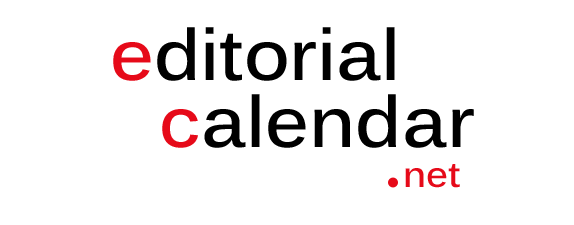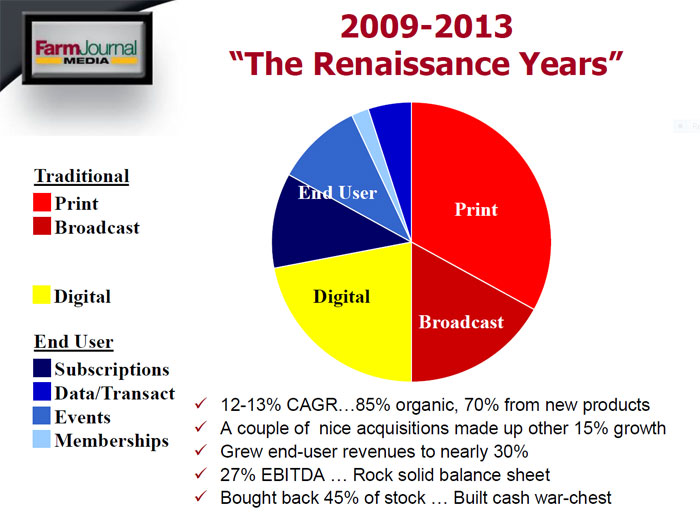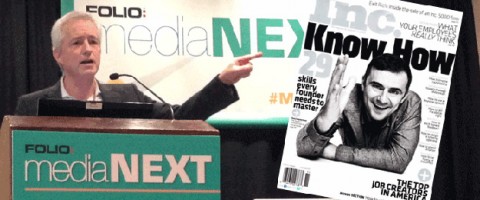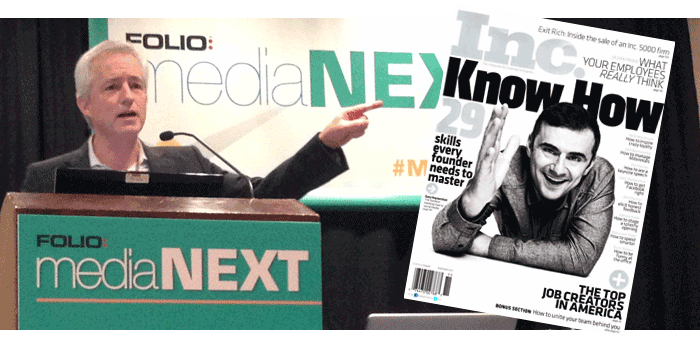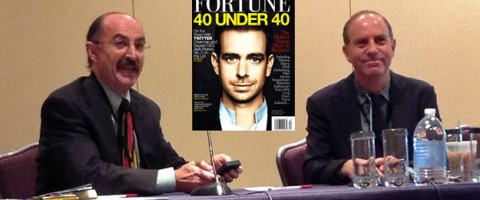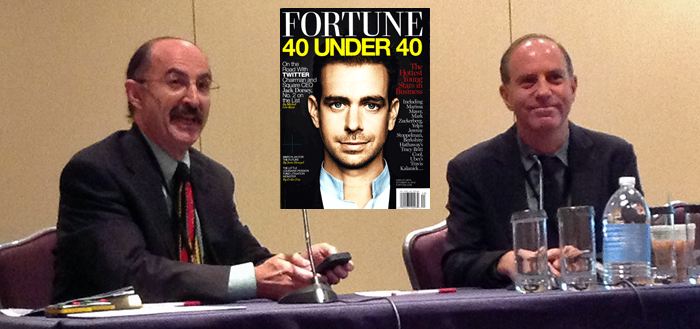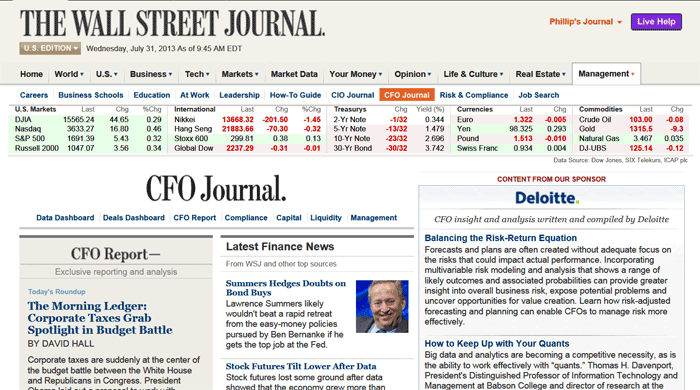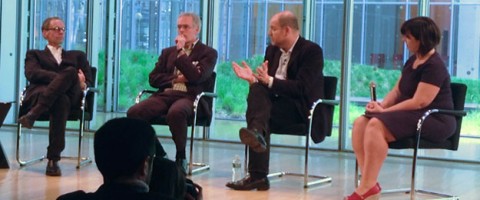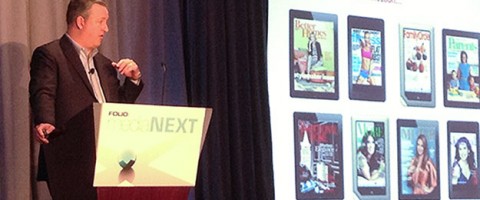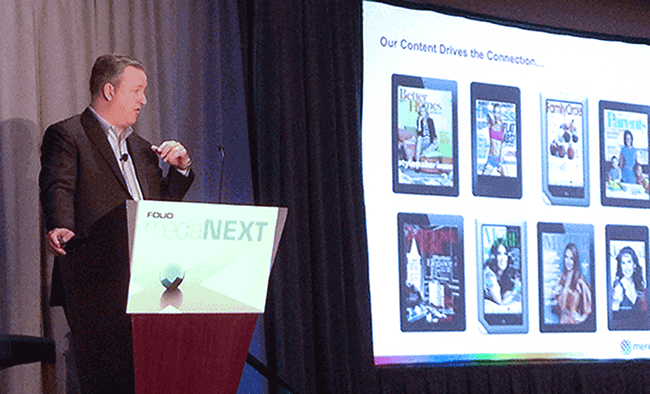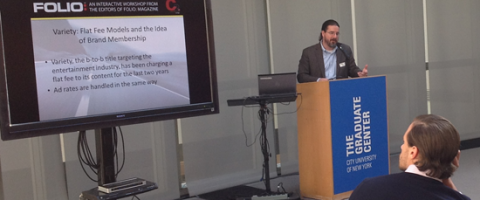Farm Journal Media Plans to Double Size (Again)
“Think a decimal bigger.” That ambitious directive from CEO Andy Weber (pictured) has become a winning mantra at Farm Journal Media, a fully integrated multimedia company that has doubled in size over the past five years.
“I want my division presidents to be concerned with $500,000 projects, not $50,000 ones,” explains Weber. “I want my sales guys to deliver $100,000 to $200,000 projects, not $10,000 to $20,000 ones.”
Double Up
Weber’s big think initiative, combined with a determination to bust silos and institutionalize innovation, has allowed his 137-year old company to fuel expansion through internal growth rather than acquisition. Today Farm Journal Media maintains 41 products that generate over 23,000,000 monthly agricultural touch points. And Weber plans to double the firm’s size again over the next five years.
Weber discussed his company’s progress and plans in a keynote address at a recent FOLIO: 100 Awards Ceremony in New York City. As might be expected, the firm has taken an aggressive plunge into digital. “We have grown our digital revenues 350 percent in the last five years,” says Weber. “It now represents well over 20 percent of our business.”
Weber highlighted one digital product: Commodity Update. This acquisition is now a multimillion dollar text marketing business that has grown to 75,000 subscribers from the 15,000 when it was purchased. It now has an 80 percent market share in the agricultural text marketing messaging business.
While only a third of the company’s revenues come from print advertising, that portion is 35 percent bigger than a decade ago. Again, the increase resulted from internal growth rather than acquisitions. Print products include the company’s flagship Farm Journal, as well as Top Producer, Beef Today, Dairy Today and Implement & Tractor.
“We're not deemphasizing print,” says Weber. “The flagship publication will always be part of our culture.” Together, digital and print revenues represent about half the company’s business.
Fueling growth
Weber attributed the company's decade-long success story to a number of growth-oriented initiatives in addition to the “think a decimal bigger” mindset. One goes under the slogan The Drive for 25. “The idea was to grow in profit 25 percent a year and maintain a 25 percent EBITDA margin (and if we go above that, plug it back into growth). Then, finally, achieve $25,000,000 in EBITDA.”
Another initiative was to break down silos. “We consolidated three sales forces--print, TV and the internet-- into one,” says Weber. “We now have three divisions working through one senior vice president of sales with one sales structure and one sales force. The division presidents obviously had to buy into that, and they really did buy into it, because they helped craft it. They were involved in it from the grass roots.”
Sales training was overhauled to reflect the new spirit of cross fertilization. Reps, for example, were trained in all media. “Our print reps learned internet and TV and our internet reps learned TV and print.”
The compensation structure has been realigned to match this new matrix, says Weber. “Each senior manager still has an annual bonus directly tied to a particular responsibility, but they also have a separate significant bonus provision that's tied to overall company performance. Then they all participate in an equity program that's tied to The Drive for 25.”
Content silos fell as well. “We added secondary responsibilities to all of our content generators, whether they were in TV, internet or print,” says Weber. Now all major industry happenings are covered with true cross content multimedia. “This gives audiences information when they want it and how they want it, and it creates an environment for advertisers to surround their customers with our products.”
Eliminating silos helped the company better serve clients with total solutions, says Weber. “Instead of competing with ourselves internally we concentrated all our efforts on solving client needs.”
New faces
The company also re-engineered its staff. “We didn't have all the right players in the right spots, we didn't have enough players, and we needed to improve the talent level in the company,” says Weber. “One of the first things we did was add a senior vice president of content development. On the content side we recruited best of class in the industry and we recruited people that got the multimedia concept.”
On the go-to-market side, the company found itself going outside the publishing industry, hiring B2B market guru Mitch Rouda when digital revenues had stalled at 10 to 11 percent of total revenues.
One of the most important initiatives was to institutionalize innovation. “Creativity has to be cultural,” says Weber. The results were favorable: Of the 26 products introduced in the past five years only three were acquired—the remainder were developed from scratch.
A big part of promoting creativity was a recognition of the attendant risk, says Weber. “You have to encourage people to take risk and you can't kill them when a project fails unless it fails for the wrong reasons.” Indeed, over the past decade the company developed around 10 projects that were failures or only marginally successful.
Do it again
Despite its rapid growth the company has managed to maintain strong financials, says Weber. “We are rock solid financially with an EBITDA margin of 27 percent and an extremely solid balance sheet that will be a springboard for future growth.”
And future growth is on the table. “We're planning to double the size of the company again in the next five years, while holding a 30 percent EBITDA margin” says Weber. “The growth will come equally from core products, from product development, and from mergers and acquisitions.”
Some special attention will be paid to end user revenues, which Weber would like to grow to 45 percent of company business from a current level of just under 30 percent. (“End user revenues” refers to subscriptions, memberships, data transactions and events.)
Weber recognizes that beefing up end user sales will require new talent. “We’ve done pretty well for a bunch of media guys, but we need more DNA from people who know how to look at pain points, devise products that sell those pain points, and then make money off pain relief. That’s what I call the end user business.”
Photo and story by Phillip M. Perry
Posted Feb. 12, 2014
Inc. Redesign Required ‘Political Acumen’
Every magazine needs to refresh its brand once in a while. But when Inc. decided its own time had come for a design makeover, editor-in-chief Eric Schurenberg (pictured) realized he had to approach the task with a certain degree of delicacy.
“We have a brand that is really powerful,” he told an audience at a recent Folio Magazine MediaNext conference. “It has been around a long time and redesigning that brand is something you want to approach very carefully.”
The wrong design moves can do more harm than good. Get too far ahead of the reader and you risk a subscriber revolt; lag too far behind and you flirt with irrelevance.
Satisfying the public, in short, is a challenge. “Readers never ask for a redesign,” Schurenberg pointed out. “In fact, after a redesign most readers write you pathetic letters saying what did you do to my magazine? Bring it back! But you have to change with the times. You have to evolve with the way readers evolve in their readership habits--whether they recognize it or not.”
Then there’s another group of stakeholders to think about. “Unlike readers, advertisers will ask for a redesign,” says Schurenberg. “They want to be next to the latest and hottest thing in an environment where their product looks good by association. If there were no other reason to redesign a publishing property, satisfying advertisers would be a sufficient one.”
Internally, a magazine redesign promises important benefits: Ripping up and reassembling a brand can help facilitate a productive editorial environment. “From the managerial point of view a redesign allows me to tell my staff we are making a clean break from the past,” said Schurenberg. “I don’t have to put myself in the position of saying that a column or an article is dumb; it’s better to say ‘we are rethinking from the ground up and doing a whole new redesign.’”
Play politics
A successful redesign engages the entire publishing team. “A redesign in the real world is not just an act of creativity; it’s also an act requiring political acumen,” cautioned Schurenberg. Everyone wants to feel included. “You have to go around to all the stakeholders and find out what they hope to achieve. That’s often very different from what you had in mind.” Every suggestion is valuable, he added: Even ideas uninformed by design expertise can be interpreted by a professional in ways that strengthen the final product.
Schurenberg consulted with staff editors as well as the company president and the directors of sales and creative. One theme common to everyone: Go big. “No one said ‘let’s just adjust things, let’s make incremental improvements,” said Schurenberg. The company president, for example “didn’t want to spend all that money and then have to report to the owner that we had something no one could recognize as being really different.”
For ideas to prime the pump Schurenberg looked at two recently retooled magazines: Garden and Gun, and Institutional Investor. “They were both designed by the same guy: Tom Brown of Vancouver,” said Schurenberg. “We decided he would be our redesign guru for the new look of Inc.”
Coordinate efforts . . .
From the start Inc. aimed for a coordinated print and web effort. “Integration is key,” said Schurenberg. “Not only artistically but also because advertisers increasingly want to see their creative in what looks like the same environment across platforms.”
A good deal of the success in doing so relies on the appeal of identical fonts which look good in both the magazine and the web. “The most fundamental element in a redesign is the choice of fonts,” said Schurenberg. “Tom Brown selected two which work beautifully together: Klavika for display and Mercury for body copy.”
 The two media are also tied together by a graphic flourish. “Tom Brown is known for little graphic signatures,” said Schurenberg. “For Inc. he designed this squiggle around the captions. I have dubbed it ‘the mark of Zorro.’”
The two media are also tied together by a graphic flourish. “Tom Brown is known for little graphic signatures,” said Schurenberg. “For Inc. he designed this squiggle around the captions. I have dubbed it ‘the mark of Zorro.’”
Coordinated they may be, but print and web also demanded substantial individual effort. Which medium would receive the initial round of attention? “We decided to start with the magazine,” said Schurenberg. In defending the ‘paper first’ approach Schurenberg suggested audience members consider their own experiences. “How many of your star subjects want to be on the cover of your magazine?” he posed. “How many find that thrilling and how many have their PR people bend your editor’s ear to get that? Now think: How many put the same effort into getting on the home page of your web site?”
But perhaps the paper-first decision relied less on sober analysis and more on the Inc. culture, suggested Schurenberg. “The magazine is the flagship of Inc. Somehow the print version of a publication confers an authority, a validation that the web site just doesn’t have.”
The most important element in the print redesign was something that was hiding in plain sight: paper. Schurenberg had learned from his previous experience redesigning Money Magazine that poor paper can muddy the best looking visuals. “From the beginning of the redesign of Inc. I made it clear that the whole exercise would be pointless if we kept using the same cut rate paper,” said Schurenberg.
Schurenberg’s appeal was successful. “The owner agreed to increase the paper quality by 40 percent. It was absolutely essential to the success of the redesign. Probably something around 50 percent of the praise this redesign has garnered is actually praise for the quality of the paper.”
. . . from web to print . . .
Print is king but web is counselor. The Inc. web site provided useful clues into reader proclivities that helped guide the print remake. One was the value audiences place on news categories. “We know that readers on the web site are used to getting channels of information,” noted Schurenberg. “Channels are useful for categorizing the huge mass of information on the web site and are also very good ways to package content for advertisers.”
In a manner similar to the web site, the print magazine content was broken down into four channels. Three were Launch (about startups); Lead (about leadership), and Innovate. The fourth channel rotates among the three topics of Money (raising or managing); Technology; and Make (about manufacturing in the US by entrepreneurs). “Every channel has its own pacing, its own short stories, a newsy upfront, features and columns,” pointed out Schurenberg. “Each is distinguished by a title page and a color.”
The web also offered insights into reader pacing in the digital era. “You can’t escape the fact that readers love listicles,” said Schurenberg. “And readers run out of steam at around 750 words for an article. So we went on to create a lot of one page stories that top out around 650 words.”
. . . and from print to web
If the web site provided reader behavior insights that could be used to redesign the paper magazine, the latter offered resources to energize the web site.
The first: photographs. “Inc., like other magazines, has a photo department with editors,” said Schurenberg. “It has relationships with photographers and studios and sends people out on shoots. We don’t do that on Inc.com; it’s hard to imagine how you could justify the cost.”
But photos from the print edition can be used on the electronic one. “We get beautiful photography, 90 percent of which doesn’t have to end up on the cutting room floor because it can move over to Inc.com”
And photography means more than just single shots: Photo essays, long popular in the print universe, can be transmogrified into online slide shows. The latter are popular, if somewhat controversial. “Slide shows are a cheap way to get clicks and are often looked down on,” said Schurenberg. That need not be the case. “If they start out as photo essays by professional photographers and are carefully thought out then you can do all the slide shows you want.”
Another print resource: infographics. “The trouble required to put them together means that on most web sites infographics are created by someone else and often associated with advertisers,” said Schurenberg. The print magazine, with its full staff, can economically justify the production of infographics that move online.
Finally, the print magazine offers its web site partner a possibly counterintuitive resource: lengthy articles. “Magazines are of course the last bastion of long form journalism,” said Schurenberg. “But let it not be said that web readers have no appetite for features.”
Schurenberg cited as example a lengthy feature, recently published in print, on the psychological cost of being an entrepreneur. “When it went online it got 50,000 shares--the second most shares of any story we have ever done--even those stories of 650 words,” said Schurenberg. “The subject touched a nerve among readers.”
White space and photos
The web site redesign presented its own challenge: How would Inc. transmute the mandate for elegance and boldness into pixels? One way was to clean up the presentation. “Our web designer Haewon Kye created a lot more white space,” said Schurenberg. “This made the site look very different from the one before which—like so many other web sites—had become more cluttered over time.”
A second element was the introduction of larger photographs. “Our original carousel images were 575 by 250 or so,” said Schurenberg. “Now they are 970 by 450. They pack a much bigger punch and make the site look better and show off the magazine photography in a much better way.”
The third decision was to offer more content. “Previously Inc. had followed the blogger river lineup on its channel and home pages,” said Schurenberg. “We went to a pin board which allowed us to service a lot more content.”
Now visitors to the Inc. web site immediately see four stories. Scrolling to the right or the left reveals four more. Hovering the mouse over the channel navigation heads uncovers still more. “Altogether without scrolling down you see 48 stories just by moving the mouse around,” said Schurenberg. “With the previous design you had to wait for the carousel and you would see five stories in 15 to 20 seconds.” The new design puts more hooks in the water to land more impressions.
 The pinboard layout also facilitated the abandonment of the customary advertising location. “Readers have been conditioned to think of the right rail as the other side of the tracks, a place where you never need to look,” said Schurenberg. In contrast, the pinboard layout allows ads to be integrated with—while clearly differentiated from—editorial. “By getting rid of the right rail we have increased our usable space and created a more fetching design.”
The pinboard layout also facilitated the abandonment of the customary advertising location. “Readers have been conditioned to think of the right rail as the other side of the tracks, a place where you never need to look,” said Schurenberg. In contrast, the pinboard layout allows ads to be integrated with—while clearly differentiated from—editorial. “By getting rid of the right rail we have increased our usable space and created a more fetching design.”
It all comes together to create an integrated experience which is immediately discernible to the public eye. “If you are walking behind someone and they drop a magazine and it opens to a spread you should know what magazine it is without looking at the cover,” said Schurenberg. “You can do that now with Inc. And if someone drops a laptop and it opens to our site you know it is Inc.—even if all you have ever read was the print magazine.”
The redesign seems to have reached its goal. “So far responses are running three to one in favor of the print redesign,” said Schurenberg. “That’s far better than I expected.” Online results, he added, are harder to come by. Not only is the redesign still too new, but web site remakes always create technical problems that can muddy the reader acceptance picture.
While the redesign has been a success, challenges remain. One of the more difficult is the feeding of the voracious picture monster. “We have a site that strives to be as beautiful as possible, so we can’t get away with stock images,” said Schurenberg. “That increases the burden on the photo editor who has to come up with interesting images that are worthy of 970 by 450. That is a full time job. We do about 40 pieces of copy a day.”
Photo and story by Phillip M. Perry
Written November 20, 2013
Fortune Sets Course on “Brands Within a Brand”
When Fortune managing editor Andy Serwer describes his occupation to an inquisitive taxi driver, the usual reaction is some variation of “oh yes—the Fortune 500.” That common refrain testifies to the importance of the magazine’s annual compendium of top performing companies—and to that list’s high level of recognition in the public imagination. “The Fortune 500 is actually a stronger brand than Fortune,” says Serwer.
That top-of-mind presence makes for plenty of opportunity. The magazine’s ongoing efforts have made the Fortune 500 theme more than just a tool for raising the profile of the publication in the public mind. As advertisers flock to glow in its aura, the Fortune 500 has become a powerful revenue generator in its own right, an example of what Serwer calls a brand within a brand, or a franchise.
Brand play
If a marketing paradigm works well for one franchise, why not for others? That was the crux of remarks made by Serwer (pictured right) during an interview with Samir A. Husni, (at left) at this year’s Publishing Business Conference and Expo, sponsored by Publishing Executive, in New York City.
After all, the Fortune 500 is just the most widely known of the magazine’s franchises. Others include the 50 Most Powerful Women, the 100 Best Companies to Work For, the World’s Most Admired Companies, and the 40 under 40. When Serwer accepted his current position in 2006 he was determined to transmute those franchises into master gears for the publication’s profit machine. “We have 18 issues a year and I want to make sure every issue has one of these franchises,” he says.
At first blush, such branding initiatives look similar to the special issues common elsewhere in magazine publishing. A franchise-based issue, after all, attracts advertisers--not only those who want to be close to a particular section but (even better) those who are happy to be anywhere at all in the issue. “That’s when you hit the sweet spot,” notes Serwer, concerning the arrival of the liberal advertising mindset. “Then you are able to do all kinds of edit.”
Triple Play
As vital as it is, though, the print platform is just one of three on which the franchise performs its magic. “We want to blow it out across all our platforms,” says Serwer in reference to print, digital and live events. “We drive advertising across all three. When someone is sponsoring one of our live events, for example, we encourage them to buy advertising in the magazine and on the web site as well.” (The magazine gets about 25 percent of its revenues from is digital platform; the remainder from print advertising and conferences).
Groundwork begins about three months in advance of a franchise roll out. Preparation for the recent 40 Under 40 was typical: The process began with a meeting of representatives from publishing, print, media relations, web, and events. This group developed a theme and hatched plans to roll it out to the target platforms.
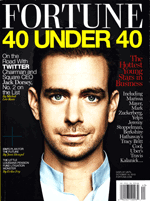 As a practical matter, print might be viewed as anchor and springboard for the other platforms. “The magazine does all the usual magazine stuff,” says Serwer. “We ask ‘What would be a great lead article? How many sidebars? What are some other articles? Charts?’ Then we plan to do a walk up: Leading up to the issue we may do a reader’s poll with questions such as ‘Who do you think are the top 40 under 40?’ We may poll CEOs and the previous 40 under 40.” In short, the magazine does anything it can to strengthen reader investment before the franchise rolls out.
As a practical matter, print might be viewed as anchor and springboard for the other platforms. “The magazine does all the usual magazine stuff,” says Serwer. “We ask ‘What would be a great lead article? How many sidebars? What are some other articles? Charts?’ Then we plan to do a walk up: Leading up to the issue we may do a reader’s poll with questions such as ‘Who do you think are the top 40 under 40?’ We may poll CEOs and the previous 40 under 40.” In short, the magazine does anything it can to strengthen reader investment before the franchise rolls out.
The digital leg on the franchise stool is more than just a simple list or article posted on the web, notes Serwer. “We do video, photo galleries, sidebars--a lot of incredibly creative stuff that works on the web or tablet.” An attempt is also made to get the involved writers and editors on TV.
The third platform comprised of live events, notes Serwer, can be tricky. They exist at three levels, each distinguished by a characteristic investment of time and money. “First, you can just throw money away--have a party,” he says. “Sometimes that’s the right thing to do. Then, at a higher level, you can have a live event sponsored by someone. That’s easy: You get a bunch of beer and a company spokesperson at the event.”
The third level of event demands more planning. “The next step is a real conference event for which people pay to come,” says Serwer. “While that is much more difficult, you start being able to have two streams of revenue: One is from attendees, who are like magazine readers; the second is from sponsors, who are like advertisers.”
As a practical matter, it can be smart to start each franchise on the first level and climb up. “We like to build events,” says Serwer. “You start small with a party and build to an event with paid attendees.”
The new editor
“Magazine, digital and conferences – I feel good about having the three legs,” says Serwer. Maybe so, but synchronizing so much activity can be quite a challenge. Today’s magazine environment is characterized by layers of complexity unheard of in the days when an editor’s job meant nothing more than guiding writers and producing copy.
While digital transformation is among the new challenges demanding attention from editors such as Serwer, he cautions against getting ahead of readers. “It is so vexing and curious and changeable in terms of the continuum of readers who want print versus digital,” he says. “Let’s take women’s magazines as an example. Our magazine In Style is putting out its biggest issues ever. Why? If you ask a reader ‘would you buy this magazine if there were no ads?’ The reader would say ‘are you kidding? Of course not. We want the ads. They are part of the experience.’ The advertisers say halleluiah. So are you going to say ‘we have to convert all our readers to digital and close down our print edition?’ No. I don’t think you have the same urgency to move to digital at all.”
Many women’s magazines, these comments suggest, might be positioned at the lower end of the digital transformation continuum. If newspapers are on the upper end, business magazines find themselves knocking about somewhere in the middle. “We have a tech savvy readership,” says Serwer. “Many of our readers have several smart phones and other mobile devices. They are trying everything all the time. So our first instinct was to rush into digital willy-nilly, and we have. Our tablet app is fantastic.”
The new reader
Even so, says Serwer, a pure digital play for Fortune would likely be a losing gamble. “We discovered, like others, that consumers have been a little slower to change over to tablets and apps than we had thought. That’s because magazines are a different experience. People are staring at screens all day long, to the extent that a magazine is a respite. That is probably a really important point of differentiation. Our magazine is vital information but is also something you can look at to provide some sort of break from work even though it is about work. It is offering long form journalism where you can lean back.”
In light of this reader behavior, Fortune is refraining from digital overreach. “We realize we need to take it easy a little bit,” says Serwer. “We need to go strong but not lose sleep over the fact that our readers are not converting as fast we anticipated. The reason is that they still like the magazine.”
So who is the digital reader? An individual pretty similar to the one for print—although there are some subtle differences. “The people arriving at the digital platform are not as different as you might think from those reading the print magazine,” says Serwer. “Yes, they are younger and there are more women. But they are still aspirational business people. They want to join the Fortune 500 companies or work there or do business with them.
“Our typical reader is a 50 year old guy getting on a plane at the airport,” adds Serwer. “But we also want to get the 26 year old Indian woman PhD at Stanford who works at Google. I think she is increasingly a reader and it’s probably true that she is more digital.”
All such digital talk refers primarily to the tablet, and that device presents magazines with a challenge that is still being defined. “This is still the early days as far as the tablet goes,” says Serwer. “It provides an experience which is as distinct from that of a web site as the magazine is from live events.” Readers can get Fortune through all of those channels, as well as mobile. “Getting information on mobile through social media is how people are increasingly getting Fortune,” says Serwer. “People read stories on Facebook and on Twitter and LinkedIn and come to the web site that way.”
The new journalist
The transmogrification of the media landscape challenge writers as well as editors. “Our journalists have to be multimedia and multitalented people,” says Serwer. “My ideal journalist is someone who writes, edits, does social, does TV, and can host live events. And especially does great long form journalism. Very few people do all those things but if I can get people who do three of those well, that’s great.”
The danger, of course, is burn out. The risk can be particularly high with a magazine such as Fortune, where a staff of scores of journalists is going up against far larger competitors. “We compete against Bloomberg and Dow Jones and Reuters-- companies with thousands of journalists,” says Serwer. “So punching above your weight is very important. We don’t have the option to let six people sit around all day and talk about some story they might do. We have to go out and get it.”
These comments inspired moderator Husni to ask if today’s journalists are being overloaded with responsibilities. “I think about that every second of the day,” says Serwer. “It’s really tough. I am scared of burning them out. People are being pulled in so many directions. It requires a lot of management; a lot of balance. And particularly for our tech journalists: They are being bombarded with new social media, new platforms and new things to try. And there seems to be a new tech website every week.”
The new company
For Fortune, the shifting media landscape is further unsettled by yet another seismic event: the spin-off of Time Inc. from Time Warner. “That adds another level of complexity which I hope none of you have to go through while simultaneously running your magazines and your web sites,” says Serwer. “It’s like playing a game of 3D chess against Mr. Spock.”
On balance, the spinoff is a net positive. “We have been a little tail on a big media company dog,” says Serwer. “We sent all our money back up to Time Warner and our CEO took that money and invested it into the movie business and HBO and Turner which was probably wise from his perspective because he could get a higher return. But it meant our magazine company was somewhat starved for capital and had our hands tied that way. And as 10 percent of Time Warner we would not necessarily get the attention and love we needed.”
Too, as a joint venture Fortune has not been able to devote the concentrated attention requisite to building a digital brand. “We have had a joint venture with CNN so that Fortune has been under the umbrella of CNN Money,” says Serwer. “That has been good on the one hand because it has provided us with a lot of traffic and a lot of dollars that follow that traffic. On the other hand our brand has been very sublimated in the digital space so if you find a story it will say CNN Money and maybe it will say Fortune somewhere.”
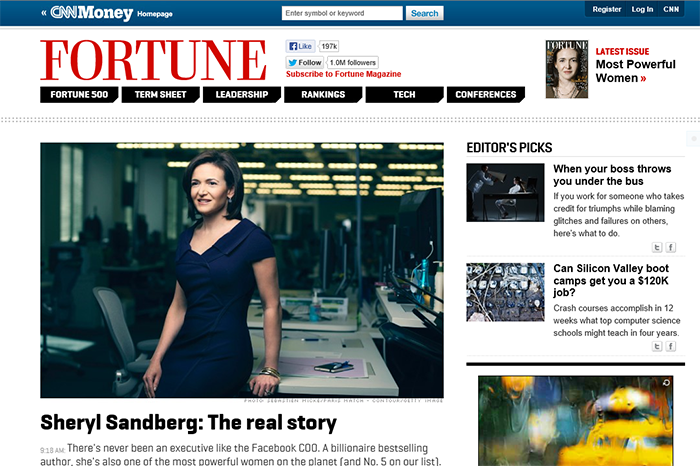
That kind of brand diffusion is not optimal, says Serwer. “Putting together a joint venture and slapping a name on it is not really brand building.” Post spinoff, the magazine will be able to invest more directly in its brand. “I am very excited that we will be able to build out our web site and digital business.”
As all of the above proceeds, Fortune will be making its decisions under a watchful public eye. “We will be an independent public company,” says Serwer “That’s slightly daunting. You can make the argument that it’s a good thing to be private during the transition because it requires a longer time frame and the public markets are usually not so good in being patient that way. On the other hand it will be great to have the visibility and discipline. You can suffer from a lack of discipline. We will be under the microscope and scrutinized and we will be held accountable to our decisions.”
The road ahead
If all goes well in its break from the past, Fortune will come out the other side as a stronger entity. “I want the spinoff to go well,” says Serwer. “I want to make sure we have the capital to invest in our web site and the wherewithal to flow through.”
Serwer anticipates that successful brand building will position Fortune for long term health. “Sure, we are going to be around this year and next, but what’s it going to be like five years from now? I want to make sure that when I leave the position of editor Fortune is a strong, sustainable, thriving journalistic enterprise. That’s my most important job.”
Story and photo by Phillip M. Perry
Written October 11, 2013
Editors Battle Advertisers for High Ground
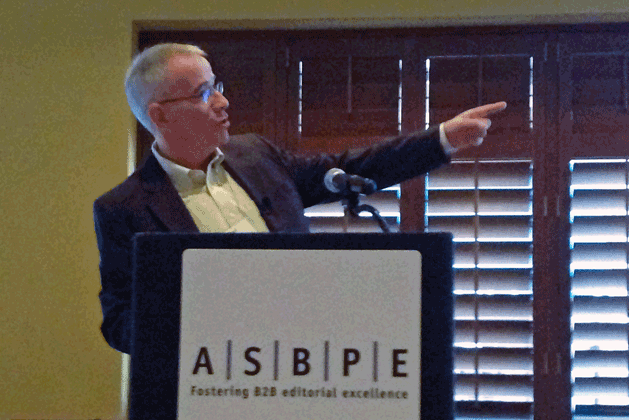
The editor was showing off the latest issue of his glossy business magazine. Big. Bulky. Packed with full page ads. Everything shouted one vigorous message: Business is great.
Paul Conley shook his head—inwardly, at least. “I didn’t have the heart to tell him all those ads were ‘make goods.’”
Grim anecdote, true. But emblematic of today’s print world, according to the veteran publishing consultant and VP of CFO Publishing. If Conley has seen many publishing trends come and go, the latest ones all seem to be pointed in one direction: down. “Things are getting worse and worse.”
Making good
The culprit is the same Internet shift gnawing at industries from newspapers to recording artists to business supply stores. Print magazine publishers, for their part, are trying a number of techniques intended to shore up profits. The problem is that advertisers are not happy with the results.
“Advertisers tend to find b2b disappointing,” reported Conley, speaking at last month’s annual conference of the American Society of Business Press Editors (ASBPE). “Not the editorial content, but the business model. That makes it harder to monetize what we do on the editorial team.”
Solutions, though, seem few. “Banner ads were doing okay for awhile, but no one is doing too well with banner ads anymore,” noted Conley. “Then publishers moved toward ‘lead generation’ sales. But lead gen is not working.”
Magazines are resorting to spamming their audiences while advertisers demand ‘make goods’ for ads that fail to pull in the promised leads. Hence the happy but hapless editor in this article’s opening story. “Sales people know about the problem but editorial teams do not,” said Conley. “They have no idea how bad things have become.”
Enter Native Advertising
Like a life saver dropped to a drowning man comes the shout of a desperate captain: Sell editorial!
No one will use those exact words, preferring the more ethically sheltered sobriquets of “native advertising” and “content marketing.” Whatever the terms, they suggest for editorial a certain shifting of ground. Publishers are seeking a way to monetize their product in a way that capitalizes on the faith readers have invested in the sacred space of the editorial temple.
“The worst piece of news I have is that that the battle for the integrity of the editorial stream is lost,” said Conley. “We lost that battle largely because people on the editorial side were not paying attention. They did not know the battle was happening. So advertisers will continue to put pressure on publishers. You will see this soon in your brand. You will either make the adjustment or your brand will continue to stumble.”
Just what is native advertising? Definitions vary by aspect, but those with deep pockets have the idea that money talks. Conley reported that in a recent emarketer.com survey, nine of 10 North American manufacturers agreed with this definition of native advertising: Content produced for or by the advertiser that runs within the editorial stream. “Not along the side,” noted Conley, “but within space that has traditionally been sacred to us. Their content runs there. That’s what they want because that is what’s working for them today.”
Rules of the Game
Intrusions by advertisers into editorial are something of an irony: Any benefits gained rely on that very tradition of an editorial cathedral the money changers threaten to sully. One might posit that at some point, when the purity of editorial is gone, the power of native advertising will diminish.
Editors, however, can take steps to maintain their integrity while acknowledging the new realities. Conley suggested setting ground rules. “This is where I want the next battle to be fought: When a publisher says we are going to do native advertising, editorial says ‘This is how we do it and it is not negotiable.’”
Conley presented the following four rules “to comfort editors, restrain the ad sales staff and make clear to media partners what you expect.”
- Native advertising must be transparently identified as an ad, even if it is in the well.
- Native advertising must be congruent with the publication’s mission.
- Native advertising must be interesting and have good copy. Editorial will decide these matters of judgment.
- The editorial staff must not work on the product. “There are a lot of really talented people that can help advertisers,” noted Conley. “Find them. Get a freelance stable and find out which ones will work with advertisers. Segregate your freelance staff.”
Going rogue
Some advertisers are bypassing the traditional editorial stream, carving out their own channels to readers. “Brands are doing their own content, getting away from us and what we have traditionally offered them,” said Conley.
An example of this is the Deloitte native advertising column that appears on the right hand side of The Wall Street Journal’s CFO section. The term Sponsored Content appears over the column of native advertising. Beneath it are the words: Please note: The Wall Street Journal News Department was not involved in the creation of the content above. If readers overlook such caveats they will be impressed by the quality of the work. “It is really good stuff,” said Conley. “They are producing stuff that I cannot argue for a second is inferior to what we do at CFO.”
The Deloitte column is just one example of an industry that has become fragmented. Other brands are starting their own tablet formatted industry magazines. New Internet vehicles are popping up, puncturing old verities and appealing to an interactive audience.
Here are some examples of feisty competitors: www.skift.com; http://www.bisnow.com/, and http://www.industrydive.com/
The b2b market, in brief, has become wildly competitive. “The old rule was that there were always three brands in every space: the market leader, the number two publication, and the new challenger,” said Conley. “Since there were only three places to get information the advertisers had to deal with us. That’s simply not true anymore.” And the more money brands put into captive editorial, produced by writers sometimes referred to as “embedded journalists,” the less money is available for advertising in traditional b2b vehicles.
At the same time, many new vehicles are producing material that is far more compelling than old b2b media’s mix of copy and pix. That can be a game changer in terms not only of profitability but also of business publishing in general, said Conley. “When was the last time you saw something in b2b that inspired you, that shook you up, that moved you? That you saw something you had not seen previously, that was truly revolutionary? When was the last time you saw something that made you walk across the office and say ‘did you see this?’ That was never a common experience in b2b. It is now.”
Aliens in the stream
A new breed of creators, better at making value and building audiences, is now challenging the world of traditional publishing. “The newer companies which are doing the moving, surprising work in b2b have a couple of things in common,” said Conley. “First they are driven by Gen X and increasingly by Gen Y. These people have lived their whole lives creating media, not just consuming it.”
Traditional executives are not prepared to compete. “Publishers are print centric, nostalgic, and are not adjusting well to the digital world,” said Conley. “And they are living within a financial structure that does not require them to be innovative. Private equity dominates the ownership of b2b. Private equity is not a business model; it is a wealth accumulation model. It’s about taking money from products for the investors, then growing the products and taking more money from them.”
That’s a recipe for short term thinking. Indeed, publishing executives very often look to flip their properties rather than spend years building a brand, said Conley. “It’s very hard to talk to those people about innovation, about investment in the staff, or about what the company will be like in 20 years.”
Anchored in text
Editorial, for its part, has also been reluctant to move forward. “We are still stuck trying to perfect the things that were important 10 years ago,” said Conley. “We have perfected print. Print is perfect.” At the same time, editors and writers are failing to master new media’s requisite skills. “We cannot edit a photo, cannot upload a video, don’t know how to record an audio. It’s extraordinary to me.”
Any editorial room conversation about the digital media tends to concentrate on old issues. As an example, Conley pointed to the continuing argument about the risk of external links causing visitors to leave a magazine’s site. That dialog is stale; the Internet has moved on. “As long as we continue to fight the battles of 10 years ago we will be unable to fight the upcoming ones,” said Conley.
Editors and writers must become more sophisticated about digital publishing, for the sake of their careers as well as their employers. “The younger people who are starting the new media companies are hiring entirely different kinds of journalists,” said Conley. “They come with new attitudes and new skill sets. It is a 100 percent cultural difference from five years ago. It makes it hard for older people like me to compete for money, attention, jobs, gigs. Younger people have a skill set I cannot duplicate.”
That, however, does not spell the end of careers. New skills can be acquired by those who are determined to do so. Reliability, revered for decades as paramount to success, is as vital today, and perhaps as scarce, as ever. Just as important, though, is flexibility: Cultivate a mind open to new media and digital procedures.
But editors and writers must do still more: They must heighten their public profiles. “It will be a lot easier to market yourself in the future if you become a leading voice in your area of coverage,” said Conley. “Move from being a reporter to being an analyst. Be media friendly. Be the person the press reaches out to on your topic. Create a personal brand.”
Photographs and text by Phillip M. Perry
August 2, 2013
Sharpening the editorial – advertising divide
The heat is on: Faced with a need to fatten revenues, publishers are pressing editors for marketing assistance. Blurring the line between content and advertising, though, can erode a reputation for impartiality valued by readers.
Magazines can avoid damage to their brands by establishing ethical guidelines. What should they be? Editors and writers attempted to answer that question during an Ethics Virtual Roundtable held by the ASBPE on June 12. Moderator Howard Rauch, Editorial Solutions, Inc., led a discussion on issues such as labeling sponsored sections, establishing suitable advisory board restraints, and dealing properly with freelance writers.
Mr. Rauch's report appears below.
Ethics News Update: At ASBPE's debut Ethics Virtual Roundtable, marketing involvement clearly was an important concern
 by Howard Rauch
by Howard Rauch
Editorial Solutions, Inc.
"I need ideas how I can reorganize the role of the editors to focus more on revenue generation. How is that possible without crossing the line between editorial and advertising, which already is blurred by more advertorials, cover tips, belly bands, etc?."
The above question, posed during ASBPE's Ethics Virtual Roundtable on June12, is a reflection of similar concerns on the minds of many attendees. This inquiry and many others involving a variety of issues were fielded by Ethics Committee members during the three one-hour conference calls scheduled that day. The following brief summary of information shared cannot replace the value of actually having attended the event.
There was extensive discussion about ethical issues pertaining to editor engagement in marketing activity. In the upcoming revised version of ASBPE's Guide to Preferred Editorial Practices, we will indicate that it's okay for senior editors to be engaged in planning advertorials or supplements. But when it comes to actual copy creation and source interviewing, such tasks should be executed by qualified freelance writers. At no time is it deemed acceptable for an article carrying a staff editor byline to appear as part of a sponsored content page or section.
We also spent some time on the issue of editorial quality deterioration -- not as much as I would have liked due to time constraints -- especially when it comes to digital content. In one recent poll conducted by my consulting company -- Editorial Solutions, Inc. -- several editors admitted that quality slippage had occurred due to to rapidly rising workloads.
I polled Roundtable attendees concerning ethical issues involving freelance/writer relationships because we wished to devote more space to that area in our Guide. The primary point of dispute appeared to be contractual agreements offered by publishers insisting that all rights to articles written by freelancers be surrendered.
Several registrants inquired about how sponsored sections with an editorial flavor should be labeled. Our ethics code already addresses this matter. For one thing, "advertorial" is not considered a proper ID. "Advertisement" or "sponsored section" are more appropriate labels. And of course, the content involved should use a graphic format clearly different from regular editorial content.
A point raised during a brief discussion about digital media was the need to establish a policy anticipating requests to "unpublish" content. If you've not yet had to deal with this matter, you can be sure the day will come when a prompt response will be required.
Several inquiries were posed by editors of association publications. The most controversial question addressed relationships with editorial boards and the best way to educate them on the value of editorial excellence and independence.
Two aspects of this dilemma were addressed by ASBPE Ethics Committee representatives: (1) Advisory boards are just that; in no way should members be allowed to dictate editorial policy; (2) sometimes disputes with board members can only be resolved via a readership study. In one case where this step was taken, results showed that some coverage board members were pressing for was of the least interest to survey respondents.
Attendees submitted several questions immediately following the event. The most interesting inquiry: Should editorial staff give its sales team a pre-publication list of vendor sources mentioned in upcoming product-oriented articles?
The answer provided was based on my consulting experience and does not necessarily reflect ASBPE policy: Of course, procedures followed depend upon the circumstances. For example, let's say you have a round-up feature focusing on product category X. At some firms, before interviews begin, editors confer with the publisher in terms of vendor sources that should be approached, sources that might be approached, and sources to be downplayed.
Mosf of the time, this is not a troublesome practice because industry leaders you'd want to interview would fall into the "should be" category. On the other hand, it's tough to ignore a top company not an advertiser that lands in the "might be" or "downplay" category. When that occurs, the publisher's directive should be disputed.
Then . . . it also is practice in some firms that when all sources have been interviewed, a list of those mentioned in an upcoming article should be provided to the publisher so the companies identified can be pitched for advertising.
As you can see, the above remarks reflect today's reality that many issues preceived as ethical dilemmas overlap with traditional marketing practice. A few B2B editors have chosen to address these matters via written policy covering a variety of situations under the banner of staff relationships with advertisers.
Moving away from the marketing area, two useful information sources deserve follow-up:
(1) Business Travel News Editorial Guidlines. This very useful list covers news gathering and reporting, external relationships, gifts and travel as well as an interesting "embargo" practice. View this list at www.businesstravelnews.com/Editorial-Guidelines/.
(2) Best practice guidelines for editors crafting social media policies. This excellent report prepared by the American Society of Newspaper Editors was referenced in a previous Ethics News Update. "Best Practices . . . " includes a list of ten key takeaways plus social media excerpts from several dailies. Go to www.asne.org, hit the resources link and then the "social media" link.
I'd like to thank Ethics Committee representatives who helped me field attendee inquiries: Paul Heney, Roy Harris, Abe Peck and Robin Sherman. Attendance at this initial Roundtable was excellent. Those of you who missed the event really should try harder to set aside an hour for future Virtual Roundtables.
Thriving in a “Twitter First” World
Twitter: Easy, rough and raucous. Journalism: Tough, refined and reflective. Can a marriage of this odd couple endure?
If the answer is “no,” it won’t be for lack of interest in a meaningful relationship. Attracted by Twitter’s rapidly growing hegemony over breaking news, publishers are struggling to thread the social medium’s chaotic feeds into legacy media’s fabric. The result is a 21st century amalgam, an uneasy alliance in which Tweets and video clips disrupt and enhance their print progenitor.
“We are seeing a fascinating morphing from the traditions of journalism,” said Mark Thompson, president and chief executive of The New York Times. “It’s broadcasting, but it’s different from broadcasting. It’s multi media, a real time cooking up and grabbing of lots of diverse textures and experiences. It has a very real time immediacy and urgency, but there’s also a lot of character in it.”
Twitter first
Thompson presented his analysis during “The Future of News Organizations in an Increasingly Social World,” a discussion held during Social Media Summit 2013 sponsored by The New York Times and BBC Academy’s College of Journalism. Participants were (pictured left to right) David Carr (moderator), Media Columnist for the New York Times; Peter Horrocks, Director of Global News at the BBC; The New York Times’s Thompson; and Janine Gibson, Editor in Chief of Guardian U.S.
The conference was held a day after the April 19 apprehension of the second Boston bombing suspect, the culminating event in what Carr described as “an extraordinary week of domestic news.” Media old and new responded to the rapidly developing story with a nervous stutter of cooperation and tension characteristic of the developing communications paradigm. “Sometimes traditional and social media feeds would morph into one another,” noted Carr. “And sometimes they would diverge and be in conflict.”
What was most apparent from the Boston reporting, though, was that Twitter has taken the lead as the first source of breaking news. “For the first time continuous TV news has come in second,” said Thompson. “Now, essentially, Twitter is first.”
Assess and enhance
First it may be, but Twitter, in its rush to report, can mislead with rumor as well as fact. “Twitter presents everything on an equivalent basis,” noted Horrocks. The danger, of course, is the temptation to rebroadcast a juicy but inaccurate Tweet. Responding to pressures from an eager public and competitive news outlets, reporters can producing copy that harms the public and the media’s reputation. “A lot of professional journalists go to Twitter to blame Twitter,” said Gibson. “But all the catastrophic things that were wrong in the Boston reporting were done by news organizations failing to report properly. If you apply the right reporting principles to your sources, whether from Twitter or otherwise, you should not get into that much trouble.”
Reporters will continually be confronted with the grey area of raw information compelling enough to warrant broadcast but absent sufficient validation. In such cases news organizations can hedge their reporting with appropriate language, employing the equivalent of what Carr called “a digital ten foot pole so you can have it but not be blamed for it.”
Hedged or not, news stories will be more authentic when the reporter has taken time for reflection. Here American journalism might learn something from its more careful British counterpart. “We know it’s best to wait, not to follow that thing from Twitter right away,” said Gibson. “We get our best people and coolest heads running the outfit, and then we say what we can see as clearly as possible.”
Successful gatekeeping requires a skill set that differs from that of traditional reportage. “The effect of stream based journalism, the need to compress things and deal with context and atomization, is in many ways more of a challenge than selecting sources and making the right judgments,” said Horrocks. “It changes the way you write and package your journalism.” The value of such curating is not lost on those flying with the social media flock. “A lot of people on Twitter are saying ‘old media is dead,’” said Carr. “But their feeds are full of links to legacy reporting.”
Open doors
In the best of cases Twitter becomes more than a valuable source of news feeds. It also enlarges the audience for traditional publishing formats. This is occurring at the BBC where reporters with hot news items are instructed to “text first” and write second. “We changed our policy a year ago from a requirement to break news first in a radio or TV broadcast piece,” said Horrocks. “All journalists now file first in text, which is the best way to get information to all of our platforms.”
The system is designed so that posts go out concurrently on BBC and individual Twitter timelines. The BBC’s audience is increased when timeline readers click URLs which take them to the legacy media’s website for stories analyzing the news. “Twitter is absolutely a friend,” said Horrocks. “It’s totally transforming the kind of journalism we are doing around the world.”
Social media can extend a media’s brand in even more dramatic ways. “Today with Facebook we are having a conversation with our audience in Burma,” said Horrocks. “That hasn’t been possible for 40 years. A group of journalists exiled in London has been broadcasting many thousands of miles away with very little information from that country. Now all of a sudden we are able to have a conversation with people there about the country’s future.”
Building the audience
If social media draw new people to a legacy brand’s website, will they stick? “How you go from a first referral from a social environment to a story at nytimes.com, and then keep readers there, drawing them in to take one more story, is the big issue,” said Thompson. Part of the answer is encouraging visitors to open a dialog with the text. “We know that people who take the time to comment are more likely than others to become subscribers,” said Thompson. “Eighty percent of the people who comment the most are subscribers.”
Publishers must also package editorial in a format that exploits the characteristic engagement of reader and device. “If we panned a camera around the audience here we would find that from 30 to 40 percent of people are using smart phones and small laptops,” said Thompson. “We need to think about the behaviors that go with these different form factors, then work out the best way to put content in front of people. We need to create really effective, clever, attractive environments which make the best use of the screen and the rest of the device.” High quality apps are part of that environment. “You can already feel that people do not want 900 apps, but a smaller number that do what they do excellently,” said Thompson.
There is a special challenge in designing appropriately for the idiosyncratic interface of the tablet. “We need to be careful with the tablet,” said Thompson. “We have all ended up with rather static, rather beautiful near facsimiles of our print products. Very few news providers are using tablets for what they can do with multimedia, sound and the moving picture.”
Such as? One example of what can be done is “Snowfall.” Written by John Branch, this report of a Washington state avalanche is, in Thompson’s words, “a fantastic mixture of a brilliant piece of text with the dropping in of intense personal experiences in amazing animated graphics.”
The bottom line
Visually stimulating. Exciting. Compelling. All of these descriptions apply to the marriage of legacy and social media. But will the partnership succeed in financial terms? There’s no doubt that a positive answer will require experimentation. Carr held up his smart phone to illustrate the challenge. “I do not see room here for a business model. It’s little. If news becomes a list, I worry that social will become the operating system in a news environment, to the detriment of media brands.”
A more sanguine view was offered by the Guardian’s Gibson: “I am old enough to remember when our lunch was going to be eaten by the Internet,” she said. “That didn’t happen. You have to have faith that you are producing something that is brilliant and appropriate to the medium. Then you will figure out how to fund it and scale your costs accordingly.”
Photo and story by Phillip M. Perry
May 29, 2013
B-to-B’s Path to Mobile Optimization – B2B @ FolioMag.com
Traffic for business content—traditionally living in the 9 to 5 world of desktops—has risen considerably on mobile devices. And that base is only getting bigger. Business publications expect more than a quarter of their audiences to access content exclusively on digital platforms within the next two years, according to a recent study by the Alliance for Audited Media (AAM).
But even though they see the rising tide of mobile users, b-to-b publishers aren’t sure how to proceed. The same AAM study reports that 60 percent are undecided about how exactly they’ll optimize for mobile. Meanwhile, close to two-thirds of consumer magazines already have a definitive approach.
B-to-b publishers ALM and FierceMarkets have begun to take significant steps to optimize their content for mobile consumption though. Both have rolled out the changes incrementally, but they’re each being careful to address the full spectrum of the user experience. Having a disjointed, part-mobile, part-desktop device strategy puts a ceiling on your mobile potential.
Read complete article by Michael Rondon:
Connecting with Consumers in Digital Times
How does a magazine publishing company survive and thrive in the digital age? By changing with the times without betraying its core mission. On the one hand the company must engineer editorial to meet the requirements of delivery channels such as social media and mobile apps, molding its product to conform to and exploit the limitations and potentialities of tablets and cell phones. On the other hand the publisher must maintain and exceed a level of editorial integrity and service that over the years have built core audience loyalty.
Known for its century-old titles such as Better Homes and Gardens and Ladies Home Journal, Meredith has been engaging in a modern day balancing act, reengineering content for the digital age while maintaining firm control over reader-focused editorial.
“For our company to keep growing we must keep thinking about how our magazine brands can connect with consumers in new ways,” said Tom Harty, President of the company’s National Media Group. Speaking at a Folio Magazine conference earlier this year, Harty illustrated the importance of digital delivery with an arresting fact: “65 percent of magazine lovers aged 18 to 34 follow a magazine editor or columnist on Twitter.”
Responding to consumer demand for multi channel delivery, the Better Homes and Gardens brand has expanded from its print origins into tablet, web sites, and mobile apps. The response has been enthusiastic, said Harty. “Technology has changed the conversation we have with consumers. Readers can now interact with our brands how and when they want to. Today almost half our connection with readers is through some sort of digital channel.”
Mobile rules
For many people, the word “digital” conjures up images of web sites. But in many cases the fastest growing digital channel is mobile, a term which embraces tablet and smart phone access. Consider the after effects of Meredith’s acquisition of allrecipes.com a year ago, a move which doubled the company’s digital footprint in Meredith’s number one content area: food. “At the time we acquired allrecipes.com 15 percent of the site’s traffic was mobile,” said Harty. “Today, after a period of less than 12 months, mobile represents 50 percent of the site’s access. And half of that traffic is happening inside a store. This is a tremendous change.”
The consumer’s embrace of mobile explains why the company’s motto is now “change plus innovation equals sustained growth,” said Harty. “Change is an opportunity to grow our brands.”
Even so, change for its own sake can backfire. Indeed, the company must not get ahead of its audience. “We know that only two to three percent of our women have switched to the tablet format,” said Harty. “We realized that simply being the first to market was not critical at this stage of the technology. It was more important to focus on delivering the content in the most appropriate format for our audiences.”
If the tablet transformation is gradual, it is sure. “We are working hard to bring our brands into the tablet era. We are true believers.”
King Content
In this royal court of publishing the Crown may be digital but the King is content. “We are not a technology products company,” Harty emphasized. “We are a content company. The curated and trusted content of our magazines and our digital media drive our connection with our core audience of 100 million women. At the end of the day we have to deliver on our brand promise.” The “crux” of Meredith’s strategy to fulfill that promise is the provision of content aligned with what Harty describes as the “three main focuses” of the company’s readers: family, home and well being.
Indeed, the house of Meredith is built upon a foundation of magazines in their ideal form of molded content. “I have to remind everyone at Meredith and in the industry how many people still love magazines,” said Harty. He offered supporting MPA numbers: “Magazines are witnessing unprecedented strong growth among consumer audiences. Print magazines are read by nine out of 10 adults and 95 percent of adults 18 to 24.”
That loyalty translates into dollars. “Consumers spend more than $300 million a month to buy magazines at the news stand,” said Harty. “And the number of brands advertising in magazines has increased 57 percent in last two years.”
Meredith’s own numbers reflect a continuing interest in magazines. “Our total magazine audience is 116 million,” said Harty. “Never before in our history have our magazines reached such a large audience. During the worst economic recession in two generations our subscription business has never been better. We are constantly reinvesting in our magazines and brands to make sure we are best in class.”
Editorial Dialog
At one level, the modern multi-channel approach has fundamentally changed Meredith’s dynamic with advertisers. Today a single sponsor might purchase a package that communicates a message through several related magazines in a number of print and digital channels. The result is a more powerful and compelling offer. “It’s not about selling ad pages anymore,” said Harty. “It’s not about selling digital banner ads. It’s about selling client solutions across many platforms.”
Equally compelling is the transformation in editorial. Mature and seasoned as it is, content continues to evolve in subtle ways as readers exploit technology to gain an interactive presence. “In today’s media world people view your brands more as a daily content experience,” said Harty. Escalating patterns of reader interactivity offer opportunities for a closer engagement of editorial with consumer needs.
Harty offered one example. “We recently reinvented the Ladies Home Journal brand, fueled by social media. The traditional way LHJ was created was that editors would sit around a table, decide what they thought was important to their readers, and create content. Hopefully readers would read something that they found interesting.”
The new editorial model allows readers to involve themselves with the content in a much more intimate way. “Social media sites are leveraged to start the conversation with readers before we actually create the magazine content,” said Harty. “These conversations fuel the brand with what really matters to its readers and help develop the original content. The editorial teams use this fuel along with their trusted expertise and external advisors and internal experts to expand ideas and fill LHJ with socially fueled vibrant content.”
The initiative has succeeded. “Over the past nine months the model has been unbelievably responded to,” said Harty. “The result has been the transformation of one of our oldest brands. We knew it would be a challenge but we also knew this brand has always been driven by highly engaged conversations with readers.”
As Meredith applies this methodology to other magazine properties it is illustrating a bright path for publishing houses to flourish in the digital age. In the process the company has transformed itself, in Harty’s words, “from a traditional print publishing company into a national marketing communications organization.”
Article and photo: Phillip M. Perry
Electronic media bring 15-18% of revenues

Bill Mickey, editor of Folio
The New York City seminar was presented in November by Folio magazine editor Bill Mickey (pictured). Also in attendance was Tony Silber, Folio general manager.
“The business model is not predictable anymore and we will be living with that the rest of our careers,” said Silber, speaking of the rapidly changing digital environment. “Every 18 months we will be asking ‘What's the next big thing?’”
Among the seminar highlights:
* Digital accounts for some 20 percent of b2b (business-to-business) advertising revenues today,
* Only 11 percent of b2b publishers believe their digital strategy is fully developed.
* B2b publishers are more sanguine than consumer publishers about print advertising.
Tony Silber, Folio general manager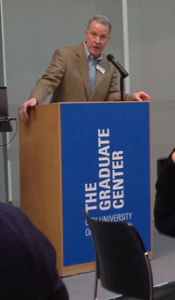
* Revenues from electronic media have not replaced revenue lost from print.
* Newsstand sales have lost 40 percent of their value in the last 10 years.
* Mobile is growing quickly; about one third of magazine websites are mobile enabled.
* Magazines are running more sponsored stories from advertisers. “Putting advertising into the content flow is the newest trend,” says Silber.
